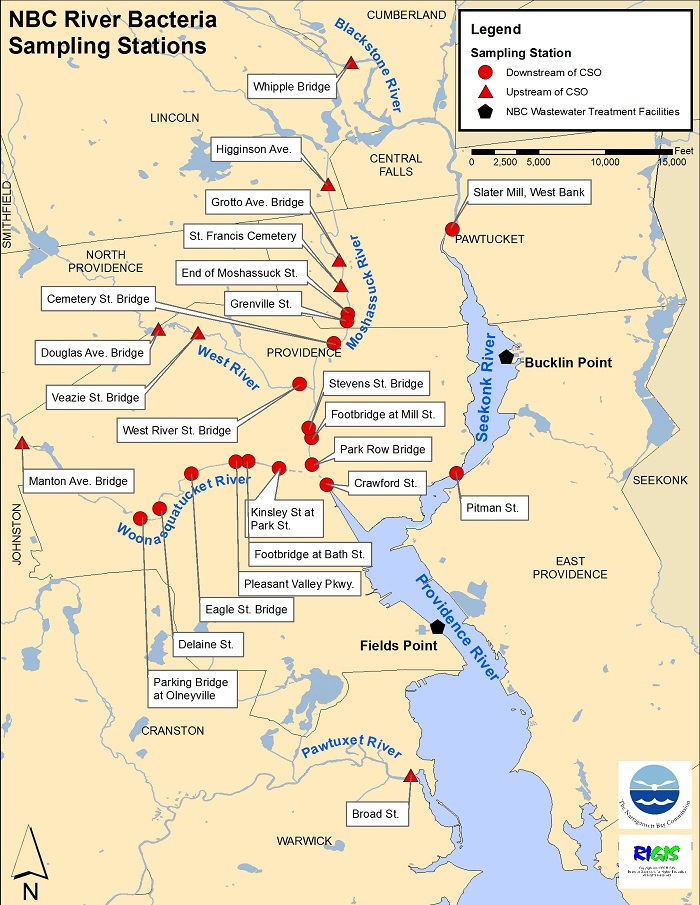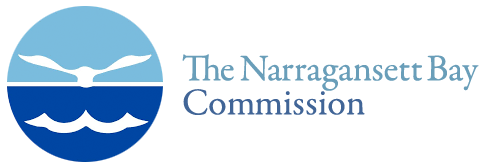Background
The NBC monitors Providence Area rivers for fecal coliform and Enterococci bacteria as part of the Combined Sewer Overflow (CSO) Abatement Project and to aid NBC’s Interceptor Maintenance (IM) section in their routine maintenance of the wastewater conveyance system. These bacteria are found in the intestines of humans and other animals, and are used as indicators of possible sewage contamination and pathogen presence in the environment. During wet weather, bacteria counts in the rivers may be elevated due to the normal functioning of the CSO system as well as the runoff of pet waste and wildlife waste in the watershed; in dry weather, elevated bacteria counts may indicate improper functioning of the collection system, and such occurrences are quickly investigated by the NBC.
Methods
The sampling locations are strategically chosen in the area rivers to help the NBC interpret bacteria levels with regards to recent rainfall and proximity to CSOs. Most rivers have a sampling location that is situated upstream of any CSO, giving a baseline reading for that river on that particular sampling day. Nineteen stations along the Blackstone, Moshassuck, West and Woonasquatucket Rivers have been monitored for fecal coliform weekly since 1998. Sampling and analysis at a subset of these stations for Enterococci began in 2007.
NBC collects bacteria samples once or twice per week, depending on the location. Samples are collected into sterile bottles, just below the surface of the river, and kept on ice until delivery at the NBC Laboratory. Samples area analyzed for fecal coliform via the multiple-tube fermentation process (Standard Method 9221 E EPA method); the Idexx Enterolert Method is used for Enterococci analysis.

Implications
The NBC’s bacteria monitoring program allows the NBC to keep an eye on the hundreds of miles of pipes and interceptors throughout the service district and quickly identify leaks or other problems. In addition, these data have been used to evaluate the improvements to water quality in the rivers and the upper Bay following Phase I and Phase II of the NBC CSO Abatement Project, which has helped increase the days the upper Bay is open for shellfishing. For information on the NBC’s bacteria monitoring in the Providence and Seekonk River estuaries, please see the Bay Pathogens Monitoring initiative page!
NBC Monitoring Station Locations
2004 NBC River Fecal Coliform Data
2005 NBC River Fecal Coliform Data
2006 NBC River Fecal Coliform Data
2007 NBC River Fecal Coliform and Enterococci Data
2008 NBC River Fecal Coliform and Enterococci Data
2009 NBC River Fecal Coliform and Enterococci Data
2010 NBC River Fecal Coliform and Enterococci Data
2011 NBC River Fecal Coliform Data
2012 NBC River Fecal Coliform Data
2013 NBC River Fecal Coliform and Enterococci Data
2014 NBC River Fecal Coliform and Enterococci Data
2015 NBC River Fecal Coliform and Enterococci Data
2016 NBC River Fecal Coliform and Enterococci Data
2017 NBC River Fecal Coliform and Enterococci Data
2018 NBC River Fecal Coliform and Enterococci Data
2019 NBC River Fecal Coliform and Enterococci Data
2020 NBC River Fecal Coliform and Enterococci Data
2021 NBC River Fecal Coliform and Enterococci Data
2022 River Fecal Coliform and Enterococci Data
